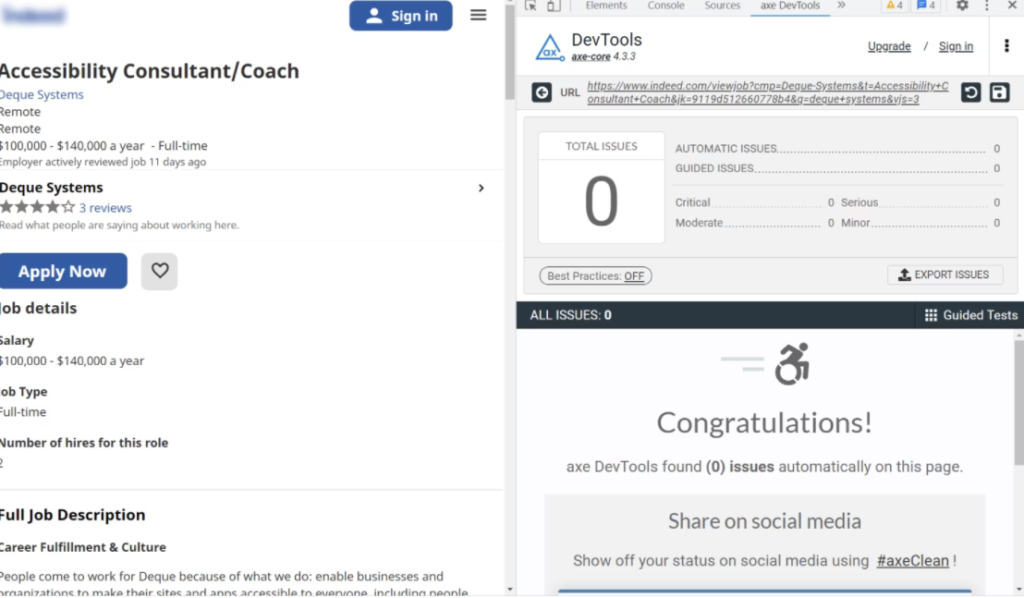Tips for Inclusive and Accessible Hiring and Recruiting
By Meagan Taylor | Deque, October 18, 2021
Some are calling it the Great Resignation,[1] others the Great Reassessment,[2] and still others the Great Jobs Mismatch.[3] One thing is clear: the 2021 hiring market presents massive shifts for employers and job seekers alike. This is particularly true for Americans with disabilities, who were disproportionately impacted by pandemic-related layoffs, exemplified by a 20% reduction of employed working-age adults with disabilities from March to April of 2020. Those with underlying health conditions that put them at increased risk for contracting COVID-19 face difficult choices about the risks they are willing to accept to return to employment,[4] further complicating job search experiences already frequently shaped by stigma.[5]
With over 8 million jobs to fill,[6] it is a critical moment for employers to reimagine their strategies for hiring and retaining employees. As workers amplify their calls for inclusion and justice in the workplace, recruiters must also seize this opportunity to evaluate the equity of their hiring processes, particularly for those with disabilities. In honor of National Disability Employment Awareness month, we sat down with Disability Rights California (DRC) staff Loule Gebremedhin, Associate Director Engagement, DEI, and Jennifer Stark, Managing Attorney, to discuss concrete strategies for employers to tap into this vast talent pool.

From myth to fact
In an era where many organizations are strengthening their culture of Diversity, Equity, and Inclusion, Disability Rights California pushes further, adding Access to the mix. Disability Rights California is a public advocacy organization advancing the rights of Californians with disabilities. Their organizational culture of Diversity, Equity, Inclusion, and Access is rooted in celebration of intersectional identities across gender identity, sexual orientation, race, ethnicity, and disability status. To build towards such a culture, employers must first confront some all too common myths about employees with disabilities. Let’s break down a few.
Myth: We’d have to lower our standards
Fact: People with disabilities are often rated above average for performance and even outperform their peers without disabilities in productivity.[7] Not only is it simply the right thing to do, disability-inclusive hiring drives gains for your bottom line. Companies that hire and cultivate inclusive cultures for people with disabilities generate 28% higher annual revenue on average, driven by increased innovation enabling teams to capture new markets with inclusive products.[8]
Myth: People with disabilities will miss work too much
Fact: Employees with disabilities often have equal if not better attendance rates than their peers without disabilities. In workplaces that offer accommodations, employees with disabilities are less likely to turn over,[9] an important consideration in the 2021 job market.
Myth: We can’t afford accommodations
Fact: 15% of accommodations cost absolutely nothing. Of accommodations that do incur a cost, 50% cost less than $500.[10] Factor in the increased profitability and shareholder returns that come with disability-inclusive hiring,[11] and your organization only stands to gain from building an organizational culture that champions individuals with disabilities.
Strategies for recruiting
So you’re ready to hire more individuals with disabilities, but how do you find and attract this talent?
Evaluate your current culture and systems
Equitable and inclusive hiring is not just about making more offers to people with disabilities. It’s about valuing the expertise and experience of employees with disabilities and supporting their professional growth through their entire journey at your organization. Start the dialogue:
- How would you describe your organization’s current culture for people with disabilities?
- How prepared are you to provide accommodations and support the retention and growth of employees with disabilities?
- How does building a more equitable hiring process for people with disabilities align with your organizational goals?
Use this dialogue to set clear goals for improving your hiring process. At DRC, for example, they have set the goal of having 50% of their staff be employees with disabilities. “We all agree that we’re seeking this out and have built policies to do this,” says Loule Gebremedhin, adding that each of their hiring panels includes at least one member with a disability and likewise, their final candidates for any role must include an individual with a disability.
Offer comprehensive benefit packages and remote work options
While benefits and perks are often a key driver in job seekers’ choice of employer, for employees with disabilities, a comprehensive benefits package is often crucial to maintaining their physical and mental health care plans. “We know that during the pandemic, mental health has become a great need. Providing mental health coverage and an Employee Assistance Program can provide essential services to staff,” says Loule. Like great benefit packages, options for remote work stand to benefit all employees, from enabling reduced commute time and lower childcare costs, to promoting higher productivity. For people with disabilities, the flexibility to work remotely also enables greater control over their environment and increased access to the supports they are already using at home.[12]
Build partnerships
From the national Workforce Recruitment Program, to state vocational rehabilitation agencies, to colleges’ disability services offices, there are thousands of organizations dedicated to helping employers and employees with disabilities find great talent matches. “There is a Disability Rights Bar Association where we frequently post our jobs. This has been a great way to get in touch with advocates with lived experience from across the entire country,” says Jennifer Stark. Building partnerships with community organizations serving individuals with disabilities can help you cultivate a strong talent pipeline from these communities.
Revise your job descriptions and application questions
The Employee Assistance and Resource Network’s guide “Encouraging Applicants with Disabilities” provides many great tips for drafting inclusive job descriptions and application questions. A key piece of advice: Consider what’s truly necessary for the job and describe what needs to be accomplished, rather than how it should be done. Do you employees need to be strong oral communicators or do they just need to communicate effectively with others? Reframing can open the door for new talent. Loule adds, “Make it explicit that you value the lived experience of people with disabilities.” In your application questions, Loule recommends providing an opportunity for individuals to voluntarily disclose a disability and making it clear that you welcome accommodations.
Ensure your application is accessible
“One of the biggest challenges for people with disabilities is where to access the job applications,” says Loule. “Many job search engines aren’t accessible so the question becomes: can they even get to the job post?” Under the Americans with Disabilities Act (ADA), employers can be held accountable even if they are inadvertently discriminating due to their application materials being digitally inaccessible. Make sure you’re not missing out on quality talent and open yourself up to legal risk by ensuring that any documents and job posting platforms you use are accessible. Not sure how? Try scanning the website where you’re posting using Deque’s free axe DevTools browser extension and learning more about document accessibility through Deque University’s Document Accessibility curriculum package.

Strategies for interviewing
You’ve recruited a diverse pool of applicants. How do you ensure your interviews enable you to secure top talent with disabilities?
Design your interviews with accessibility in mind
Rather than simply reacting to requests for accommodation, design your process proactively to be as accessible as possible. Interviewing in person? Consider if your location is accessible to a candidate using a wheelchair. Interviewing online? Consider if you’ve chosen a platform that’s digitally accessible. For example: Within Deque, we use the Zoom platform with human-generated captions or ASL as needed.
In designing your process, plan questions and activities aligned to the skills required for the job and think through areas where accommodations may be needed. Jennifer recommends thinking through the flexibility you can provide all applicants. For example, can you provide questions in advance? Can you vary the structure of interviews? Can you provide flexible timing or format for an assignment? She advises, “Right now, the dynamic is challenging for everyone. Everyone needs flexibility and there’s an opportunity to normalize the fact that everyone needs accommodation sometimes.”
Create clear protocols for responding to requests for accommodation
Under the ADA, employers are legally required to provide reasonable accommodations for job interviews.[13] Again, be proactive. Think through areas where accommodations may be needed and create clear protocols for asking for and responding to requests for accommodation. Explain your interview process in advance and ensure all candidates are asked if they need anything to fully participate in the hiring process. This makes clear that you welcome accommodations and allows both you and the candidate time to meaningfully plan for accommodations.
Train your hiring managers
The biases of hiring managers are a core driver of lower rates of employment for people with disabilities.[14] Ensure your hiring managers receive training to build awareness of their potential biases and put structures in place to mitigate these biases, like including people with disabilities on your hiring panels. Have clear policies in place regarding ethical and ADA-compliant questioning in interviews and ensure this guidance is clear to anyone who will be conducting interviews. Ensure all are versed in basic disability etiquette to create a welcoming environment for candidates with disabilities.
Making the offer
Once you’ve selected a great candidate and made an offer, ensure this is the first step in joining an equitable and supportive work community.
Ensure your offer is competitive
People with disabilities are often paid lower wages than their colleagues without disabilities, exemplified by policies still in place which allow workers with disabilities to be paid less than minimum wage.[15] Ensure pay equity by evaluating if the offer is competitive within the job market and on par with offers made to employees without disabilities entering similar roles.
Have clear systems in place for accommodations
Ensure all employees are clear on their right to request reasonable accommodation and have a clear system in place for responding to these requests. The Job Accommodation Network is a great free resource for consultation and ideas towards providing meaningful accommodations.
Build out mentoring and retention programs
Ensure you retain the talent you’ve brought on board by offering custom mentoring and retention programs for and by employees with disabilities. Disability:IN highlights companies doing just that, providing specialized mentoring, education, and networking opportunities to support the growth and leadership of employees with disabilities.
Universal Design for hiring
Designing hiring with disabilities in mind builds a process that is more equitable for all applicants, shaping a stronger organizational culture across the board. Implementing strategies like those shared by Loule and Jennifer of Disability Rights California will ensure your workforce better represents the diversity of the market, driving increased innovation on your teams. By evaluating your organizational commitment to individuals with disabilities, you’ll be able to more clearly define and advance your organizational values and desired impact. We’d love to hear what strategies you’re implementing to champion employees with disabilities. Share your comments below.
Additional resources
For employers
Employer Assistance and Resource Network: EARN is a free resource educating organizations on how to build disability-inclusive workplace cultures.
Job Accommodation Network: JAN provides free and confidential guidance to employers on workplace accommodations.
Getting to Equal: the Disability Inclusion Advantage: This report by Accenture summarizes the business case for accessible and inclusive hiring with examples of practices implemented by Disability Inclusion Champions.
For job seekers
Disability Rights California: The Disability Right California Work Incentives Planning and Assistance (WIPA) Program offers employment counseling to eligible individuals with disabilities in California.
Ticket to Work: This program offers job counseling, training, and placement services to individuals receiving Social Security disability benefits.
Sources
[1] https://www.npr.org/2021/06/24/1007914455/as-the-pandemic-recedes-millions-of-workers-are-saying-i-quit
[2] https://www.washingtonpost.com/business/2021/05/07/jobs-report-labor-shortage-analysis/
[3] https://www.washingtonpost.com/opinions/the-great-jobs-mismatch/2011/06/19/AGWdB3bH_story.html
[4] https://www.nga.org/wp-content/uploads/2021/03/SEED_Memo.pdf
[5] https://link.springer.com/article/10.1007/s10869-018-9602-5
[6] https://www.washingtonpost.com/business/2021/05/07/jobs-report-labor-shortage-analysis/
[7] https://link.springer.com/article/10.1007/s10869-018-9602-5#ref-CR56
[8] https://www.accenture.com/t20181029T185446Z__w__/us-en/_acnmedia/PDF-89/Accenture-Disability-Inclusion-Research-Report.pdf
[9] https://link.springer.com/article/10.1007%2Fs10672-008-9063-5
[10] https://askjan.org/topics/costs.cfm?csSearch=2546498_1
[11]https://www.accenture.com/t20181029T185446Z__w__/us-en/_acnmedia/PDF-89/Accenture-Disability-Inclusion-Research-Report.pdf)
[12]https://www.cnn.com/2021/08/10/health/remote-work-disabilities-pandemic-wellness-trnd/index.html
[13]https://www.eeoc.gov/laws/guidance/job-applicants-and-ada
[14]https://www.nber.org/papers/w21560
[15]https://www.npr.org/2020/09/17/912840482/u-s-agency-urges-end-to-below-minimum-wage-for-workers-with-disabilities
About This Article:
A Life Worth Living has copied the content of this article under fair use in order to preserve as a post in our resource library for preservation in accessible format. Explicit permission pending.
Link to Original Article: https://www-deque-com.cdn.ampproject.org/c/s/www.deque.com/blog/tips-for-inclusive-and-accessible-hiring-and-recruiting/amp/

